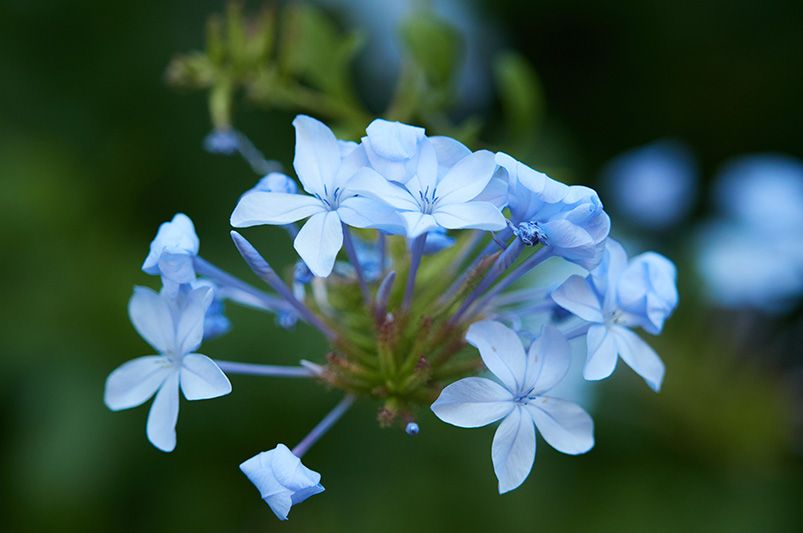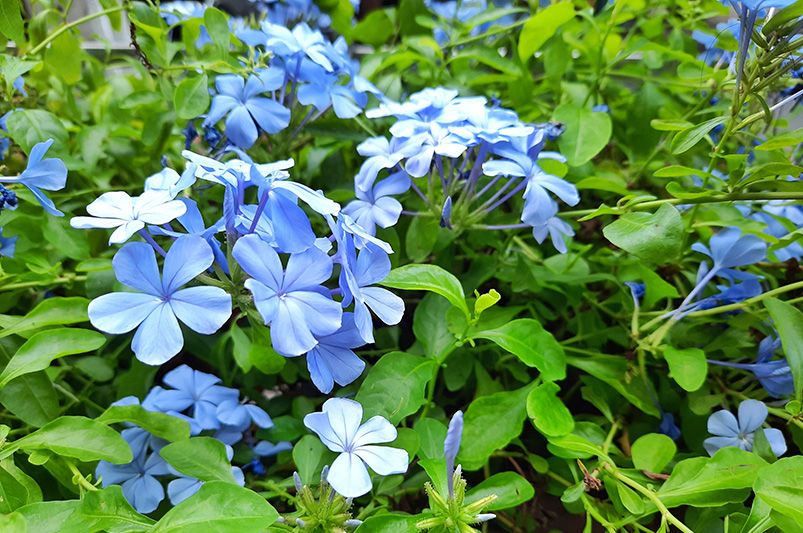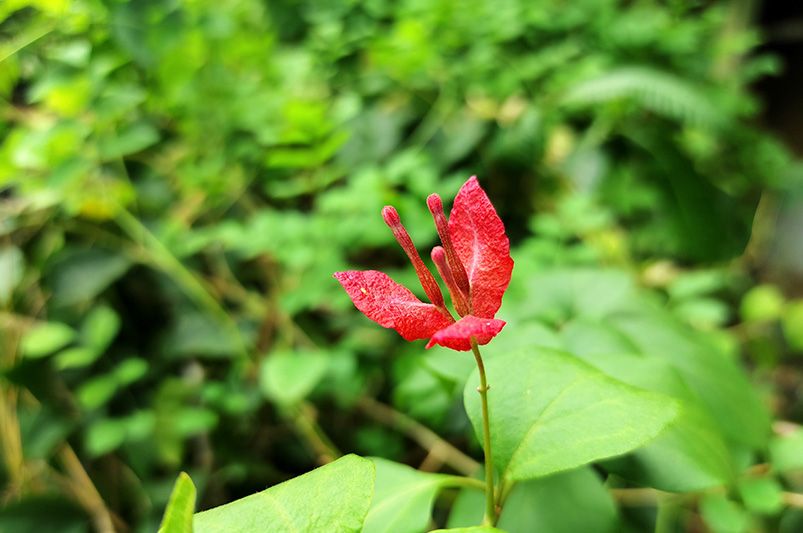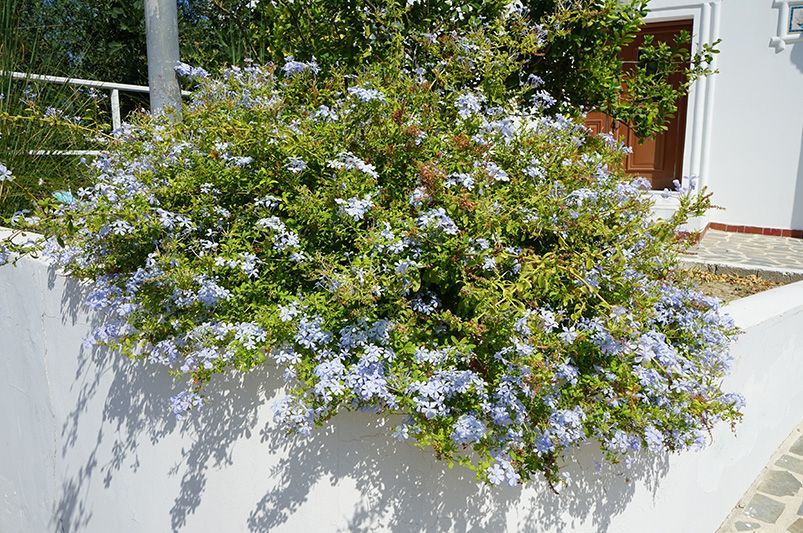
Blue Marvels: Maximizing the Potential of Plumbago
Published: 09/07/2024 | Updated: 09/07/2024
Ceratostigma plumbaginoides, also known as Blue Plumbago, is one of the unique plants that yields stunning blue flowers. This versatile leadwort, valued for its vibrant blooms, can be cultivated as a shrub, vine, or potted plant.


It grows quickly and works great as a hedge, trellised screen, or spilling over walls and fences. Its flowers are a common addition to butterfly gardens because they draw pollinators from far and wide. Blue plumbago, which is hardy only in the warmest regions of the world, is typically cultivated as an annual in more moderate climes, but it can also be overwintered in a pot.
If you’ve fallen in love with this blue-toned blooming plant, we’ve compiled some of our best tips and tricks to cultivate a beautiful Plumbago in your yard.
Care Tips
Plumbago grows sprawlingly and is often cultivated as an evergreen shrub. It can be trained to climb or drape using trellising, which makes it a versatile shrub that is suited to many outdoor spaces. Whatever shape you decide on, upkeep is necessary to keep it looking its best. As long as it is planted in rich, well-draining soil, this ornamental is not too particular about growing conditions.
Light Needs
When exposed to the sun for six or more hours every day, Plumbago grows well. It does require at least two hours of direct sunlight, but it adjusts well to partial shade. Potted plants that overwinter as perennials should be kept in a well-ventilated space.
Soil
All varieties of soil will work just as well for this leadwort as long as they drain well and are rich in organic matter. Aim for a sandy soil texture whether planting in pots or the ground. This plant’s health benefits from a neutral pH that is either slightly acidic or slightly alkaline; however, excessive note that alkalinity can cause foliage to deteriorate.
Watering
Plumbago can withstand droughts once established, but frequent irrigation produces the brightest blooms and the longest-lasting. The average water requirements for Plumbago are about one inch per week, which is enough for optimal functioning.

Heat and Humidity
Originating from South Africa’s coastal regions, it flourishes in warm, humid temperatures and can withstand salt. An environment conducive to rapid growth is one with temperatures over 60°F. Plumbago is root hardy down to 10°F and evergreen to 25°F. The colours of flowers might fade during periods of excessively high temperatures.
Here’s an interesting tidbit: in its native South Africa, Plumbago is not only admired for its beauty but also used in traditional medicine. Local healers have utilized its roots and leaves to treat warts and broken bones, adding a fascinating layer to this plant’s appeal.
Fertilizer Preferences
Apply a balanced NPK 10-10-10 delayed-release fertiliser to the plant twice a year, in the spring and the autumn.
How to Prune
For this fast-growing plant to have a pleasant appearance, pruning is necessary. Plants with many branches tend to cling to one another and develop suckers. Cut down perennial plants in late winter or early spring, and remove suckers, as flowers are formed on new growth. Throughout the growing season, deadhead spent flower clusters consistently. Any sick or damaged stems that crossover can be removed at any time.
If you are growing Plumbago as a vine, it will need some form of support. Arching stems require tying to a stake or trellis because they don’t have tendrils to adhere to them.
Propagation
During the growing season, when the plants are at their most vigorous, Plumbago can be propagated using cuttings, so get your shears ready along with a few small pots with holes for drainage, high-quality potting soil, and rooting hormone, and proceed as follows.
-
Cut a green stem that is about 4 to 6 inches long. Cut just below a leaf cluster.
-
Leave one or two sets of leaves at the top and trim off any terminal buds.
-
After dipping the lowest third in water, apply rooting hormone.
-
Create a deep, narrow planting hole in the middle of a pot filled with dirt using your finger or a pencil. For every cutting, use a single pot.
-
Make sure to preserve the rooting hormone as you insert the cutting into the hole.
-
Fill the pot with water, then cover it with plastic.
-
Position so that the soil is kept moist and bright where it can receive indirect light.
-
In two to three weeks, new shoots should emerge above the ground.

Growing From Seed
Plumbago can be planted from seeds, stem cuttings, or root cuttings. Planting from seeds is a straightforward procedure that can be started indoors and moved outdoors when the weather is suitable. To cultivate plumbago from seeds, use this guide.
1. Plant your seeds. Place your seeds in little planting pots with potting soil filled, about a quarter of an inch deep. Plant one seed per pot, then lightly moisten and cover the seeds firmly to reduce light and air exposure.
2. Let your seedlings sprout. To retain heat, cover your containers with plastic and store them somewhere bright. To keep the soil moist, mist the top inch of soil. In between waterings, let the top layer of soil dry out.
3. Leave your seeds to harden. After around four weeks in their growing pots, your plumbago seeds should sprout into seedlings. To help them acclimatise to outside temperatures, move their containers outside. During the first summer, keep them out of direct sunlight and shield them from the wind. When autumn’s first frosts arrive, move your growing containers inside.
4. Plant your young plants. By the spring or autumn of the following year, your plumbagos should be prepared to be planted in their last location. For your plumbago, dig a hole deep enough to support its root system. Select a planting location that receives full sun or some shade.
Potting
Plumbago Increase the container size by one pot every three years when you repot in the spring. When plants have gone into dormancy in the autumn, they can also be repotted.
Remove the plant by loosening the dirt surrounding the root ball. After removing any extra dirt, proceed with any yearly pruning. Add high-quality, well-draining potting mix to the larger pot. Finally, position the plumbago at the centre, then fill up the area around the roots, maintaining the level of the root ball as it was in the original pot.
Winter Care
Plumbago can be overwintered as a perennial in pots indoors in USDA zones 8 and below, or it can be left in a sheltered spot to grow dormant.
When the temperature routinely falls below 50°F, move the plants indoors. Providing your plant with enough light during its indoor hibernation is a challenge. If the natural light is not enough, place it in a well-lit room or think about adding a grow light.
Decrease the frequency of watering and do not apply fertiliser until the spring, when fresh growth emerges. Plants can be put back outside when the temperature is consistently 50°F or above.
If you want your plant to overwinter as a dormant one, trim it back in late autumn and take pots into a cold, dark place, like a basement or unheated garage. Plumbago roots can withstand temperatures as low as 10°F, but the leaves may withstand up to 25°F.
Although foliage may wither away, it will swiftly reappear in the spring. When the temperature stays above fifty degrees, cut back on watering and move plants back outside.
Plumbago Types
The plumbago family includes the following plants, among many other flowering species.
1. Cape leadwort (Plumbago auriculata): Found in warm climates (like Florida or Texas), cape leadwort is also known as sky flower or cape plumbago. It is a herbaceous perennial native to South Africa. It is a fast-growing climber that produces pale blue flowers that resemble phlox and oblong, green leaves and it’s an annual plant in other climates.
2. Blue Plumbago Plant/Hardy plumbago (Ceratostigma plumbaginoides): The wiry, rhizomatous shrub native to China, often called blue leadwort, develops swiftly and is a common ground cover. This plant has deep blue cobalt flowers and prefers full sun, though it can also tolerate moderate exposure.
3. Scarlet Plumbago (Plumbago indica): This kind of plumbago, sometimes referred to as Indian leadwort or scarlet leadwort, has red flowers when it blooms. The scarlet plumbago plant can reach a width of three feet and a height of two feet. This cultivar prefers partial shade and grows best in USDA zones eight through eleven.
4. Common leadwort (Plumbago europaea): Grown primarily in Europe and Central Asia, common leadwort is also referred to as European leadwort. Its five oblong lobed flowers bloom in a range of pink colours.
5. Burmese plumbago (Ceratostigma griffithii): Burmese plumbago has circular leaves that turn crimson in the autumn and can reach heights of three feet. It also features dense branches. During its summer blooming season, this drought-tolerant plant produces cerulean blue flowers.

Add Some Plumbago Magic to Your Yard
With its striking blue flowers, the Plumbago is a versatile and rewarding addition to any garden. This adaptable plant can be grown as a shrub, vine, or even in pots, making it perfect for a variety of garden styles. Its vibrant blooms not only add a pop of color but also attract pollinators, enhancing the overall garden ecosystem.
Caring for Plumbago is straightforward: it thrives in rich, well-drained soil and enjoys plenty of sunlight. Regular watering and occasional feeding with a balanced fertilizer will keep it flourishing. Pruning is essential to maintain its shape and encourage fresh growth, and it can be easily propagated from cuttings or seeds.
Whether you’re looking to create a lush hedge, a trellised screen, or a beautiful cascading display over walls and fences, Plumbago can do it all. Plus, if you live in a cooler climate, you can still enjoy this plant by overwintering it indoors.
Achieve Garden Greatness with ShrubHub
However, achieving the perfect setup for your Plumbago—and ensuring it thrives—can sometimes be challenging. This is where the expertise of ShrubHub’s landscape professionals can make all the difference. With their extensive knowledge and experience, they can help you design and implement a garden that not only showcases the beauty of Plumbago but also meets all its growing needs. Let ShrubHub assist you in creating a vibrant, healthy garden space that you’ll enjoy year-round.


